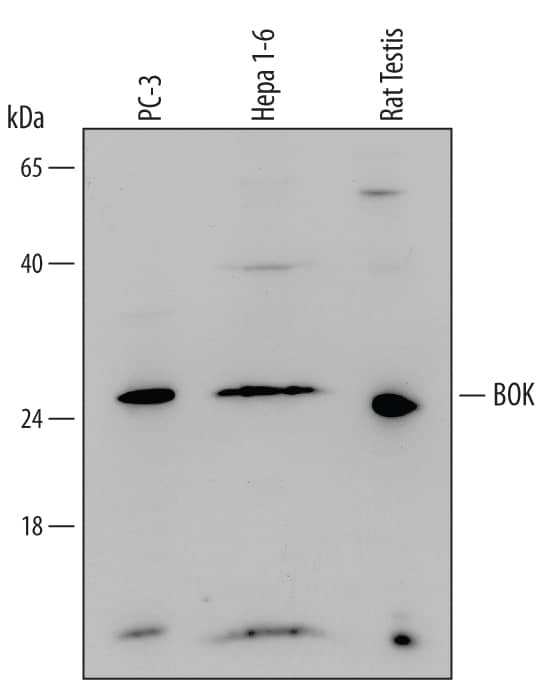Human/Mouse/Rat BOK Antibody
R&D Systems, part of Bio-Techne | Catalog # AF6067

Key Product Details
Species Reactivity
Validated:
Cited:
Applications
Validated:
Cited:
Label
Antibody Source
Product Specifications
Immunogen
Met15-Val123
Accession # Q9UMX3
Specificity
Clonality
Host
Isotype
Scientific Data Images for Human/Mouse/Rat BOK Antibody
Detection of Human, Mouse, and Rat BOK by Western Blot.
Western blot shows lysates of PC-3 human prostate cancer cell line, Hepa 1-6 mouse hepatoma cell line, and rat testis tissue. PVDF Membrane was probed with 1 µg/mL of Goat Anti-Human/Mouse/Rat BOK Antigen Affinity-purified Polyclonal Antibody (Catalog # AF6067) followed by HRP-conjugated Anti-Goat IgG Secondary Antibody (Catalog # HAF109). A specific band was detected for BOK at approximately 27 kDa (as indicated). This experiment was conducted under reducing conditions and using Immunoblot Buffer Group 2.Applications for Human/Mouse/Rat BOK Antibody
Western Blot
Sample: PC‑3 human prostate cancer cell line, Hepa 1‑6 mouse hepatoma cell line, and rat testis tissue
Formulation, Preparation, and Storage
Purification
Reconstitution
Formulation
Shipping
Stability & Storage
- 12 months from date of receipt, -20 to -70 °C as supplied.
- 1 month, 2 to 8 °C under sterile conditions after reconstitution.
- 6 months, -20 to -70 °C under sterile conditions after reconstitution.
Background: BOK
BOK (Bcl-2-related ovarian killer protein; also Bcl2L9 and Mtd) is a 27 kDa member of the Bax subgroup of the Bcl-2 family of molecules. It is expressed in spermatocytes, ovarian granulosa cells, and liver cells. BOK is activated by E2F proteins, and sensitizes replicating cells to apoptosis when under stress. It is normally found in the cytosol, and upon activation, becomes incorporated into mitochondrial membranes. Human BOK is 212 amino acids (aa) in length and contains one BH4 domain (aa 32‑44), one BH3 domain (aa 66‑82), a BH1 domain (aa 112‑131) and a BH2 domain (aa 164‑178). A potential transmembrane span has been identified between aa 189‑210. BOK heterodimerizes with Mcl-1, BHRF-1, Bfl-1 and Bnip3, and is known to form heterooligomers. There are two potential splice variants. One contains an alternative start site at Met145, while another shows a five aa substitution for aa 117‑212. Over aa 15‑123, human BOK shares 94% aa identity with mouse BOK.
Long Name
Alternate Names
Gene Symbol
UniProt
Additional BOK Products
Product Documents for Human/Mouse/Rat BOK Antibody
Product Specific Notices for Human/Mouse/Rat BOK Antibody
For research use only
